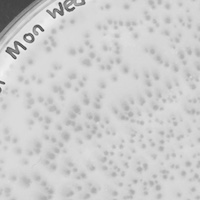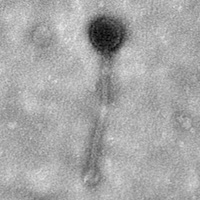| Detailed Information for Phage Kiko | |
| Discovery Information | |
| Isolation Host | Gordonia terrae 3612 |
| Found By | Mira Patel |
| Year Found | 2017 |
| Location Found | Pittsburgh, PA USA |
| Finding Institution | University of Pittsburgh |
| Program | Science Education Alliance-Phage Hunters Advancing Genomics and Evolutionary Science |
| From enriched soil sample? | No |
| Isolation Temperature | 30°C |
| GPS Coordinates | 40.44555 N, 79.9561 W Map |
| Discovery Notes | Kiko was collected from soil on 1/9/17. On that day, the temperature was -3.9oC, and it was windy with a little snowfall. The soil was transported for approximately 10 minutes before it was brought to the laboratory. The soil was covered with snow and mulch on the top. The bottom layer of soil which was collected was softer. |
| Naming Notes | Kiko was the name of my pet bird. |
| Sequencing Information | |
| Sequencing Complete? | Yes |
| Date Sequencing Completed | May 22, 2017 |
| Sequencing Facility | Pittsburgh Bacteriophage Institute |
| Shotgun Sequencing Method | Illumina |
| Sequencer Used | Illumina MiSeq |
| Read Type | Single-end reads |
| Read Length | 150 bp |
| Approximate Shotgun Coverage | 2706 |
| Genome length (bp) | 44268 |
| Character of genome ends | 3' Sticky Overhang |
| Overhang Length | 10 bases |
| Overhang Sequence | TCCTCGGTCA |
| GC Content | 66.5% |
| Fasta file available? | Yes: Download fasta file |
| Characterization | |
| Cluster | DB |
| Subcluster | -- |
| Cluster Life Cycle | Temperate |
| Lysogeny Notes | Plaques formed by Kiko all are clear meaning that it is most likely a lytic phage using only the lytic cycle to reproduce. However, I must conduct lysogen testing to prove this assumption. |
| Other Cluster Members | |
| Annotating Institution | University of Pittsburgh |
| Annotation Status | In GenBank |
| Plaque Notes | Plaques are mostly small and round, 1 mm in diameter. Some of the plaques do seem to have a tear-drop extension on it. The plaques are clustered together near one end of the plate. There was a little size discrepancy of the plaques on my original plaque purifications. The slight difference between the plaques is because Kiko is affected by direction. Since the bench is not exactly leveled, it would be microscopically deeper at one point; this difference means a lot to a phage because at the microscopic level a phage is much more affected. The difference in level effects the top agar and host cells when they are cooling on the plate. One end of the lawn would be slightly deeper than the other. There are smaller plaques where the agar is deeper because the phage did not diffuse as much. |
| Morphotype | Siphoviridae |
| Number of Genes | 67 |
| Number of tRNAs | 0 |
| Number of tmRNAs | 0 |
| Has been Phamerated? | Yes |
| Gene List |
Click to ViewKiko_1 Kiko_2 Kiko_3 Kiko_4 Kiko_5 Kiko_6 Kiko_7 Kiko_8 Kiko_9 Kiko_10 Kiko_11 Kiko_12 Kiko_13 Kiko_14 Kiko_16 Kiko_15 Kiko_17 Kiko_18 Kiko_19 Kiko_20 Kiko_21 Kiko_22 Kiko_23 Kiko_24 Kiko_25 Kiko_26 Kiko_27 Kiko_28 Kiko_29 Kiko_30 Kiko_31 Kiko_32 Kiko_33 Kiko_34 Kiko_35 Kiko_36 Kiko_37 Kiko_38 Kiko_39 Kiko_40 Kiko_41 Kiko_42 Kiko_43 Kiko_44 Kiko_45 Kiko_46 Kiko_47 Kiko_48 Kiko_49 Kiko_50 Kiko_51 Kiko_52 Kiko_53 Kiko_54 Kiko_55 Kiko_56 Kiko_57 Kiko_58 Kiko_59 Kiko_60 Kiko_61 Kiko_62 Kiko_63 Kiko_64 Kiko_65 Kiko_66 Kiko_67 |
| Submitted Minimal DNA Master File | Download |
| Publication Info | |
| Uploaded to GenBank? | Yes |
| GenBank Accession | MK284521 |
| Refseq Number | None yet |
| Archiving Info | |
| Archiving status | Archived |
| SEA Lysate Titer | 2x10^10 pfu/mL |
| Date of SEA Lysate Titering | Feb 13, 2017 |
| Pitt Freezer Box# | 55 |
| Pitt Freezer Box Grid# | H6 |
| Available Files | |
| Plaque Picture | Download |
| Restriction Digest Picture | Download |
| EM Picture | Download |
| GenBank File for Phamerator | Download |

